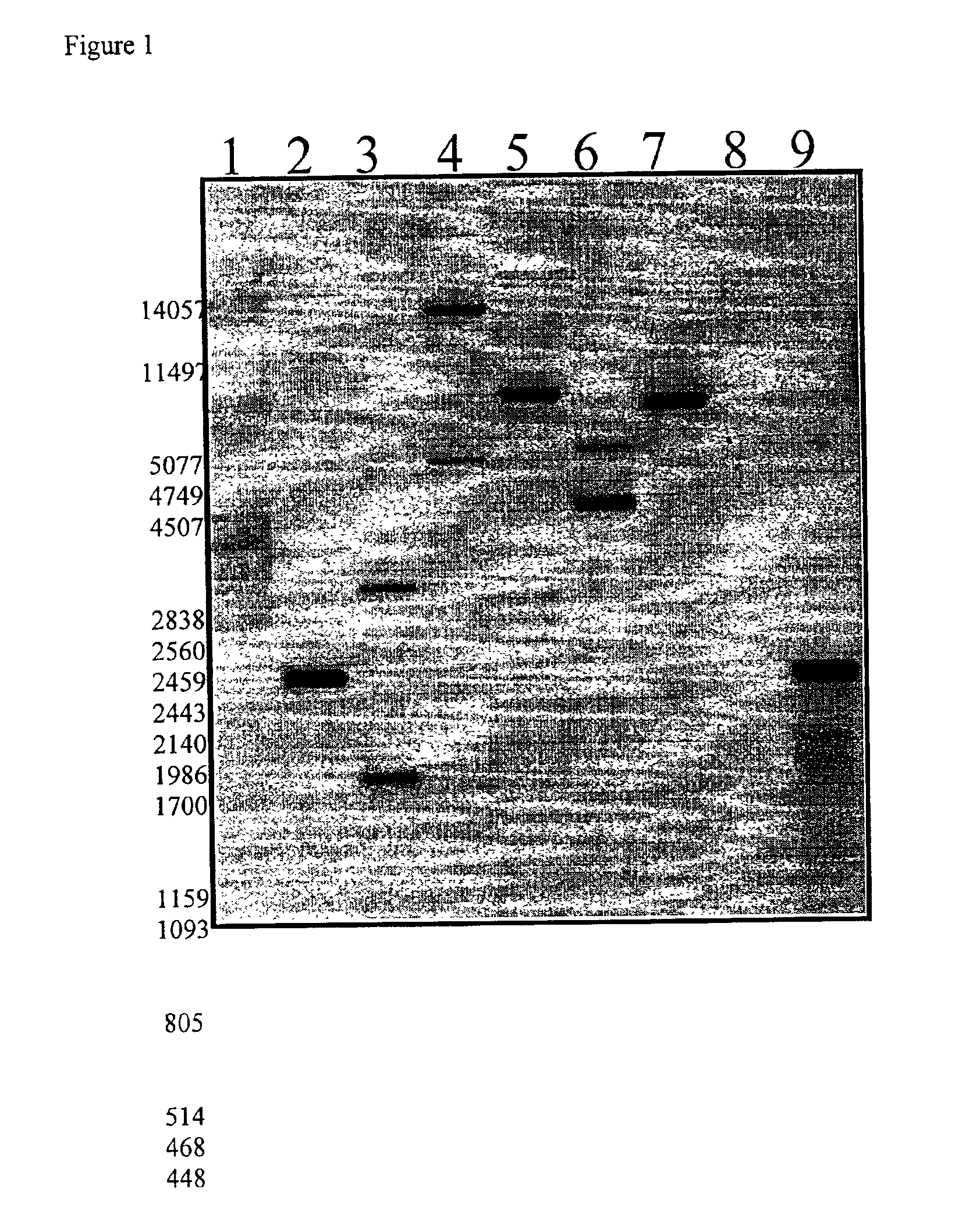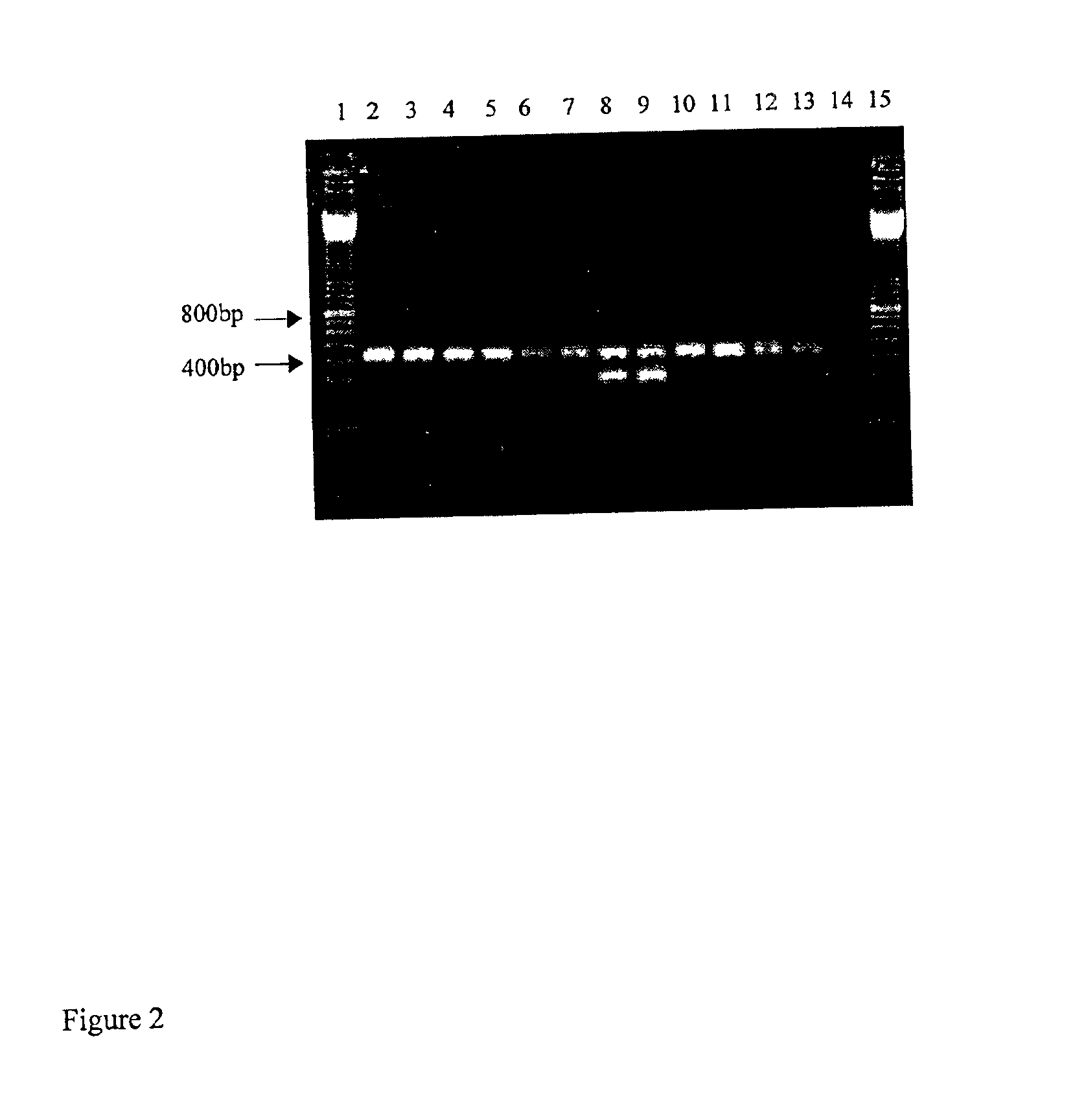Glufosinate tolerant rice
a technology of glucosinate and rice, applied in the field of rice plants, can solve the problems of common threat to the production of rice and unattractive crop economics, and achieve the effect of improving the yield or growth of rice plants and improving the growth ra
- Summary
- Abstract
- Description
- Claims
- Application Information
AI Technical Summary
Benefits of technology
Problems solved by technology
Method used
Image
Examples
example 1
Transformation of Rice with a Gene Encoding Herbicide Resistance
[0102]a) Construction of the chimeric DNA comprising the bar gene under the control of a 35S promoter (pB5 / 35Sbar)
[0103]A plasmid pB5 / 35Sbar was constructed following standard procedures. The sequence of plasmid pB5 / 35Sbar is given in SEQ ID NO:1. Digestion with PvuI-HindIII yielded a 1501 bp fragment which comprised the following genetic elements:
[0104]
NucleotidecoordinatesGenetic elements2140-2195Sequence derived from pUC19 (Yanish-Perron et al., Gene33:103-119, 1985)2196-2204Synthetic polylinker sequence2205-2398Complement of 35S terminator (T35S) from CaMV(Franck et al., Cell 21:285-294, 1980;Pietrzak et al., Nucl. Acids Res. 14:5857-5868, 1986)2399-2417Synthetic polylinker sequence2418-2969Complement of bar gene from Streptomyces hygroscopicus(Thompson et al., EMBO J. 6:2519-2523, 1987)2970-2985Synthetic polylinker sequence2986-3517Complement of 35S promoter (P35S) from CaMV(Franck et al., (1980); Pietrzak et al., ...
example 2
Development of Events
[0109]a) Development of Transgenic Homozygous Lines
[0110]The various T0 hemizygous plantlets were transitioned from tissue culture, transferred to greenhouse soil, and allowed to flower and set seed. Plantlets were evaluated for fertility, fecundity and tolerance to glufosinate ammonium. 19 plants were selected for further analysis. T1 seed produced by selfing was collected from these plants and grown in the field. T1 plants were sprayed with Liberty™ herbicide at 800 grams active ingredient per hectare (g.a.i. / ha; recommended dosage for farmers is 400 g.a.i. / ha). The events that survived the herbicide application and segregated 3:1 for herbicide tolerance were selected for further evaluation. Tolerant plants were evaluated for damage (leaf tip burn).
[0111]T2 seeds were harvested from panicles of all tolerant plants of selected events. These were sown in rows and T2 plants were sprayed with Liberty™ herbicide (1600 g.a.i. / ha) to evaluate segregation of the herbi...
example 3
Characterization of Event GAT-OS2
[0120]a) In-depth Molecular and Genetic Analysis of the Locus
[0121]Once the GAT-OS2 event was identified as the event in which expression of the transgene as well as overall agronomic performance were optimal, the locus of the transgene was analyzed in detail on a molecular level. This included detailed Southern blot analysis and sequencing of the flanking regions of the transgene.
[0122](1) Southern Blot Analysis Using Multiple Restriction Enzymes
[0123]Leaf tissue was harvested from transgenic and control plants. Total genomic DNA was isolated from leaf tissue according to Dellaporta et al. (1983, Plant Mol. Biol. Rep., 1, vol.3, p.19-21). The DNA concentration of each preparation was determined by measuring the optical density in a spectrophotometer at a wavelength of 260 nm.
[0124]10 μg of genomic DNA was digested with restriction enzyme in a final reaction volume of 40 μl, applying conditions proposed by the manufacturer. The time of digestion and / ...
PUM
| Property | Measurement | Unit |
|---|---|---|
| volume | aaaaa | aaaaa |
| pH | aaaaa | aaaaa |
| length | aaaaa | aaaaa |
Abstract
Description
Claims
Application Information
 Login to View More
Login to View More - R&D
- Intellectual Property
- Life Sciences
- Materials
- Tech Scout
- Unparalleled Data Quality
- Higher Quality Content
- 60% Fewer Hallucinations
Browse by: Latest US Patents, China's latest patents, Technical Efficacy Thesaurus, Application Domain, Technology Topic, Popular Technical Reports.
© 2025 PatSnap. All rights reserved.Legal|Privacy policy|Modern Slavery Act Transparency Statement|Sitemap|About US| Contact US: help@patsnap.com


